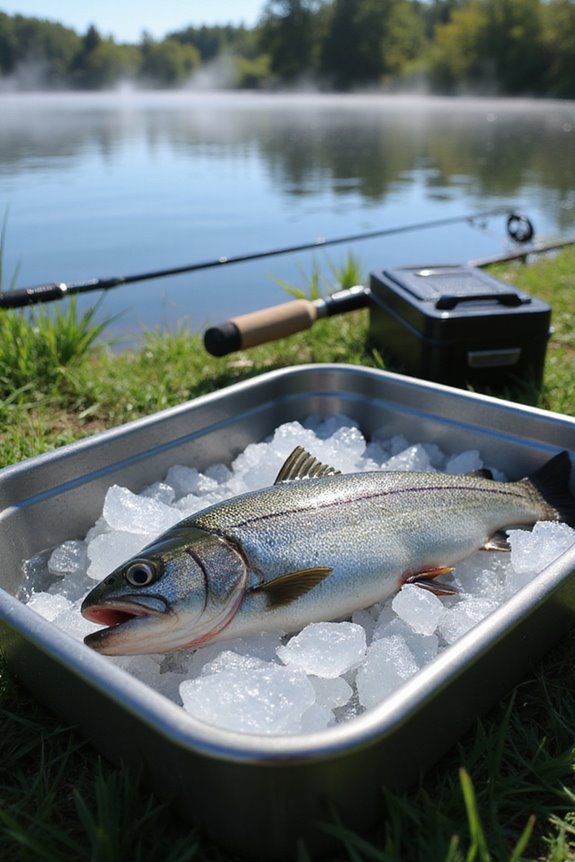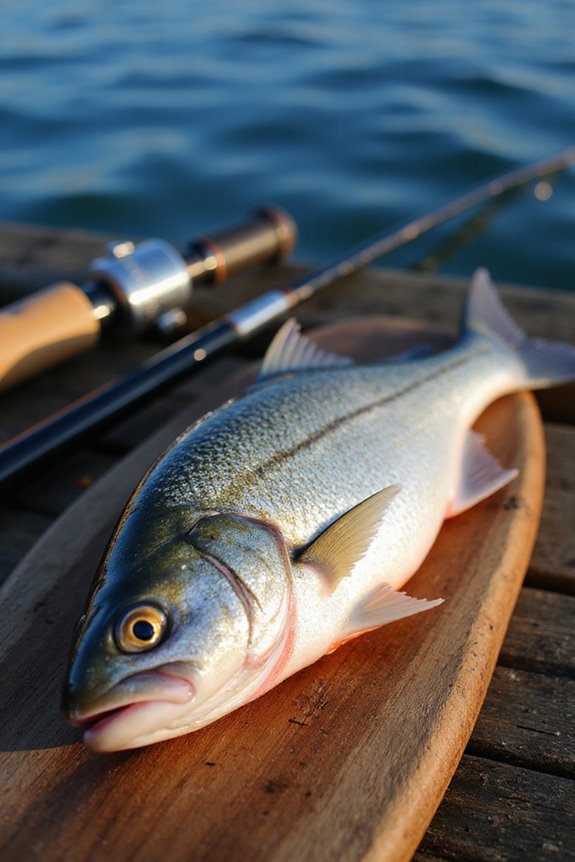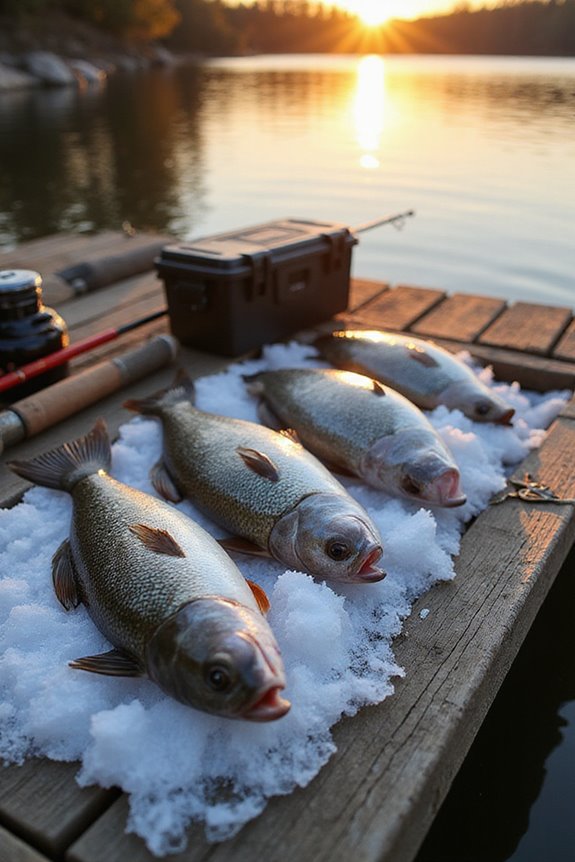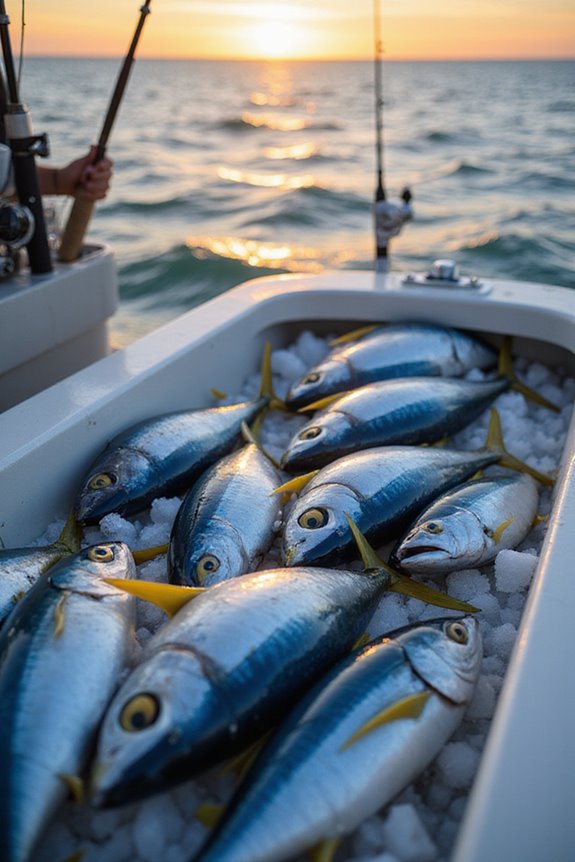When storing fish in the fridge, I recommend consuming raw fish within 1 to 2 days and cooked fish within 3 to 4 days for best quality. Check temperatures; your fridge should be at or below 40°F (4°C). For freshness, place fish on the bottom shelf, wrapped tightly. Avoid cross-contamination by keeping it separate from other foods. If you need longer storage, consider freezing methods to maintain its quality—a practice worth exploring for future catch.
Key Takeaways
- Fresh fish should be consumed within 1 to 2 days after purchase to ensure quality and safety.
- Cooked fish can be stored in the refrigerator for 3 to 4 days, with USDA recommending 3 days for optimal safety.
- Always store fish at temperatures below 40°F (4°C) to prevent bacterial growth and spoilage.
- Wrap fish tightly in plastic wrap or foil and place in airtight containers to maintain freshness and prevent contamination.
- Monitor fridge temperature and check for spoilage signs like off odors or slimy texture before consuming fish.
Storage Duration for Raw Fish
When it comes to storing raw fish in the fridge, understanding the right duration is crucial for maintaining freshness and safety. I recommend consuming fresh fish within 1 to 2 days after purchase for peak taste. If you buy fish, check for spoilage indicators like unpleasant odors, discoloration, or a slimy texture. Store fish at 40 °F (4.4 °C) or lower, ideally on the bottom shelf, where it’s coldest. To enhance freshness, wrap the fish tightly in plastic wrap or foil, or keep it in its original packaging. If you can’t use it within this timeframe, consider freezing it to prolong its shelf life. For those who fish regularly, using a bucket with proper insulation like a 1-inch foam liner can help maintain stable temperatures when transporting your catch home. Always prioritize freshness to guarantee a safe and enjoyable cooking experience.
Storage Duration for Cooked Fish
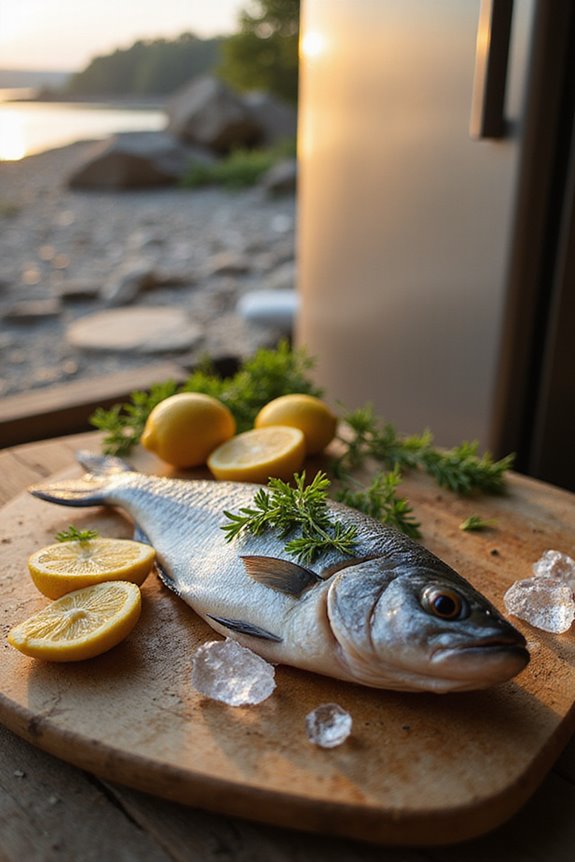
Storing cooked fish properly is essential for both safety and quality, especially since it can easily spoil if not handled correctly. I recommend keeping cooked fish in the refrigerator for no more than 3 to 4 days. The USDA suggests not exceeding 3 days to guarantee safety. If you notice any spoilage signs, like a sour smell, slimy texture, or discoloration, it’s best to discard it, regardless of how long it’s been stored. To maintain quality, place cooked fish in airtight containers in the coldest part of your fridge, ideally below 40°F (4°C). Label your containers with the cooking date to track storage duration accurately. Always refrigerate cooked fish within 2 hours after cooking for maximum freshness. Having a reliable emergency radio with NOAA Weather Alerts can help you stay informed about power outages that might affect refrigeration during severe weather events.
Proper Refrigeration Practices
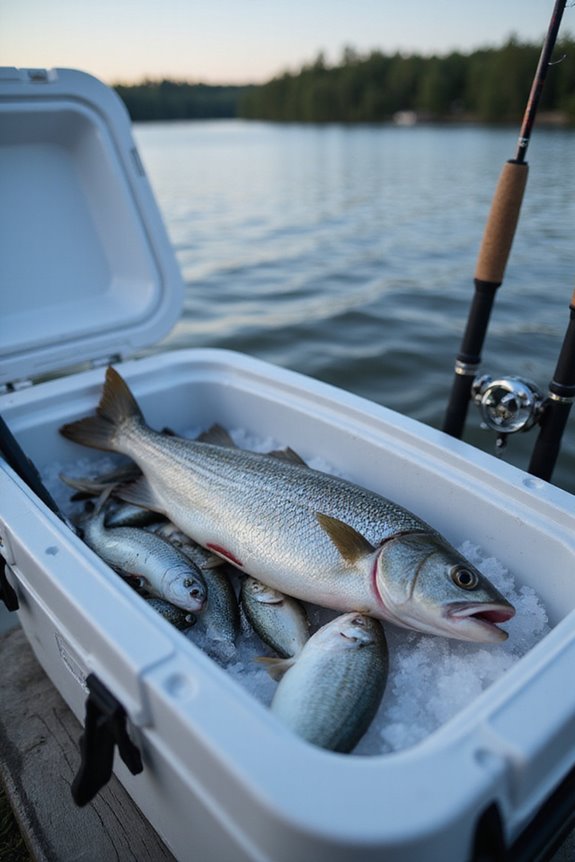
Proper refrigeration practices are essential for maintaining the quality and safety of fish. I always store fish at temperatures as close to 32°F (0°C) as possible. Using ice or ice packs beneath the fish helps achieve this. It’s vital to keep my refrigerator at or below 40°F (4°C) for food safety. I regularly monitor the fridge temperature with a thermometer to avoid any fluctuations that could spoil the fish.
Hygiene practices are equally important. I wash my hands thoroughly before and after handling raw fish to prevent contamination. I use clean utensils and surfaces, and I store fish separately from other foods, especially ready-to-eat items. By minimizing handling, I reduce the risk of introducing bacteria, ensuring the fish remains fresh longer. When organizing my refrigerator, I use principles similar to tackle box organization to keep fish products accessible and properly separated from other foods.
Freezing for Longer Storage

Freezing fish effectively can extend its shelf life considerably, allowing me to enjoy fresh flavors long after my fishing trips. To maintain seafood quality, I use proper freezing techniques. First, I wrap fresh fish tightly in moisture-proof bags to prevent freezer burn. I often use plastic wrap followed by aluminum foil for extra protection. Vacuum-sealing is another preferred method, as it helps preserve the fish’s texture and flavor. For shellfish, I place shucked varieties in sealed containers. It’s essential to freeze fish at 0 °F (-18 °C) or below; I keep my freezer’s coldest spot for this purpose. Finally, I label packages with the freezing date to track their storage time effectively, ensuring I enjoy my catch at its best.
Safety Considerations and Handling
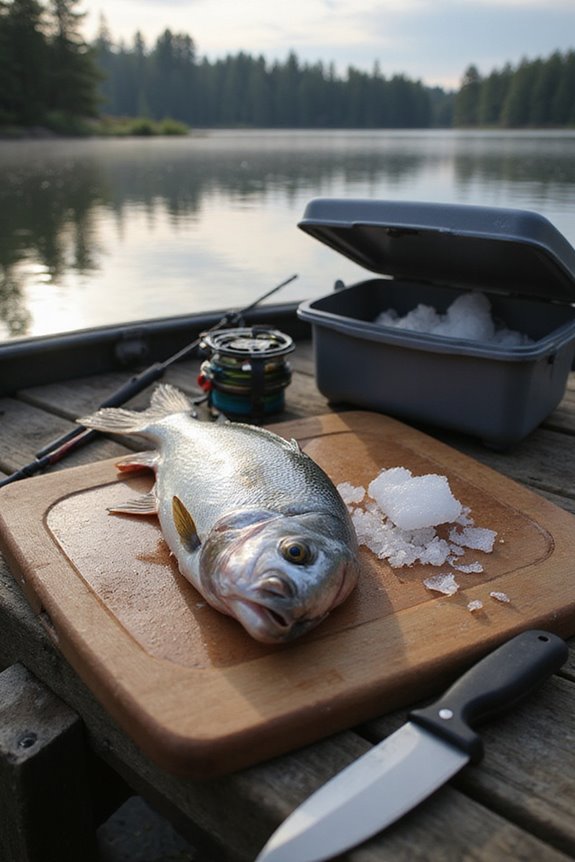
Guaranteeing the safety of fish starts with the right handling practices, especially after bringing my catch home. I always store seafood at 40°F (4°C) or below to prevent bacterial growth. Using a refrigerator thermometer helps me maintain this temperature consistently. Placing fish in the coldest part of the fridge and using ice packs can extend its freshness. I avoid cross-contamination by keeping fish in its original packaging or tightly sealed containers and never placing it directly on refrigerator shelves. I wash my hands thoroughly before and after handling raw fish. Finally, I check for any signs of spoilage, like off odors or sliminess, and discard any unsafe fish to guarantee my meals are both fresh and safe.
Frequently Asked Questions
Can I Smell Fish to Determine Its Freshness?
Absolutely, I always assess fresh fish by its fish odor! If it smells like the sea, I’m good to go. But if it’s strong or sour, I steer clear—safety first, always!
How Do I Know if Fish Is Spoiled?
I always check for visual signs like cloudy eyes and brown discoloration. I also feel for texture changes; fresh fish is firm, while spoiled fish feels mushy or slimy. If in doubt, I discard it.
What’S the Best Way to Thaw Frozen Fish?
Imagine a gentle river, flowing cool and clear. For safe thawing, I prefer refrigerator thawing overnight or quick cold water methods. These thawing methods keep fish fresh, flavorful, and safe to enjoy.
Can I Refreeze Fish After It Has Thawed?
Sure, you can refreeze fish after it’s thawed, but it’s essential the thawing process was safe. If it’s been in the fridge the whole time, you’re good to go, just check for quality!
How Should I Store Fish for Camping Trips?
When packing fish for camping, I treat my cooler like a treasure chest. I use ice packs and airtight containers to keep everything fresh and safe. That way, my catch stays delicious for our outdoor feast!

